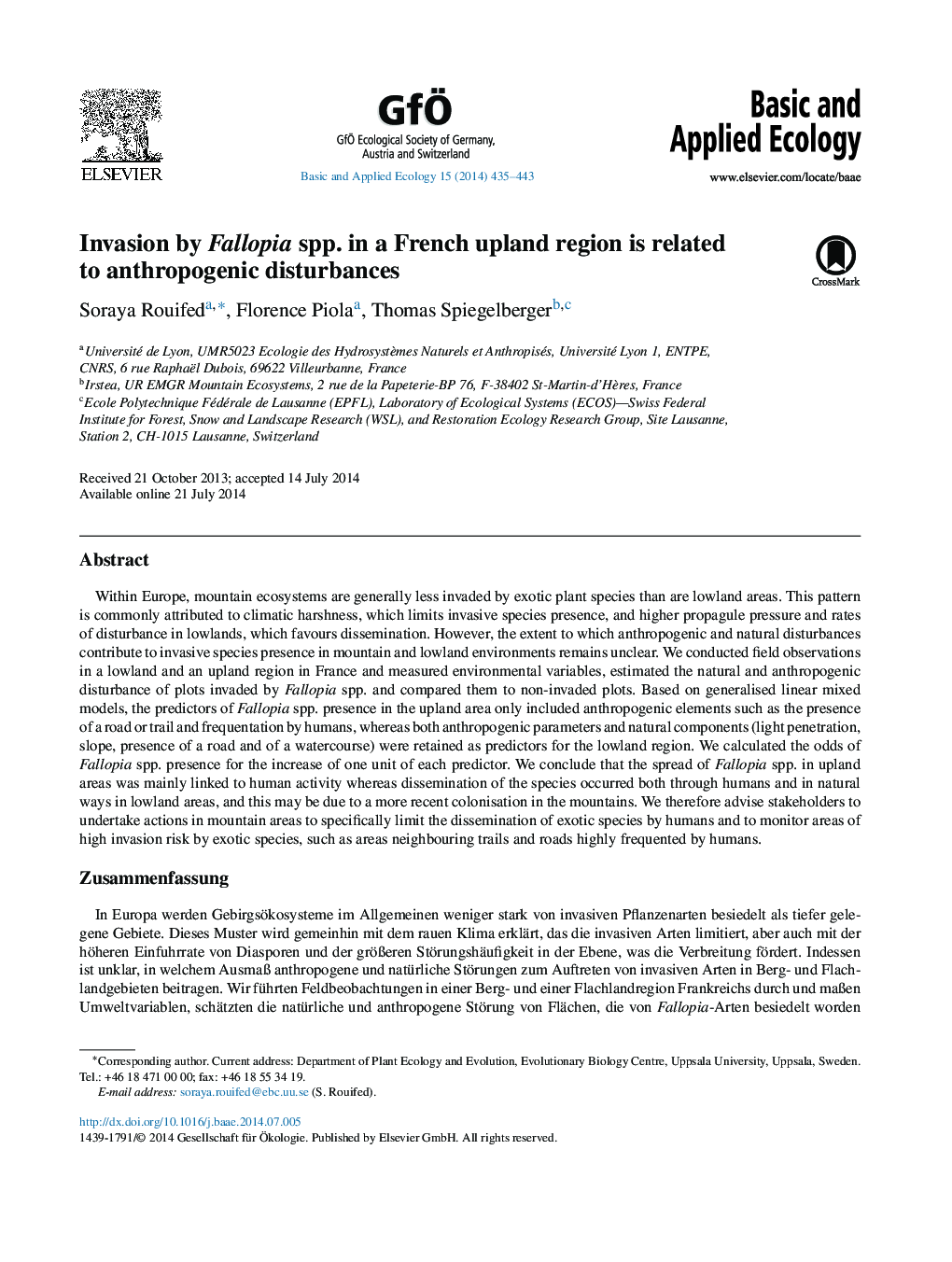| کد مقاله | کد نشریه | سال انتشار | مقاله انگلیسی | نسخه تمام متن |
|---|---|---|---|---|
| 4383957 | 1304378 | 2014 | 9 صفحه PDF | دانلود رایگان |

Within Europe, mountain ecosystems are generally less invaded by exotic plant species than are lowland areas. This pattern is commonly attributed to climatic harshness, which limits invasive species presence, and higher propagule pressure and rates of disturbance in lowlands, which favours dissemination. However, the extent to which anthropogenic and natural disturbances contribute to invasive species presence in mountain and lowland environments remains unclear. We conducted field observations in a lowland and an upland region in France and measured environmental variables, estimated the natural and anthropogenic disturbance of plots invaded by Fallopia spp. and compared them to non-invaded plots. Based on generalised linear mixed models, the predictors of Fallopia spp. presence in the upland area only included anthropogenic elements such as the presence of a road or trail and frequentation by humans, whereas both anthropogenic parameters and natural components (light penetration, slope, presence of a road and of a watercourse) were retained as predictors for the lowland region. We calculated the odds of Fallopia spp. presence for the increase of one unit of each predictor. We conclude that the spread of Fallopia spp. in upland areas was mainly linked to human activity whereas dissemination of the species occurred both through humans and in natural ways in lowland areas, and this may be due to a more recent colonisation in the mountains. We therefore advise stakeholders to undertake actions in mountain areas to specifically limit the dissemination of exotic species by humans and to monitor areas of high invasion risk by exotic species, such as areas neighbouring trails and roads highly frequented by humans.
ZusammenfassungIn Europa werden Gebirgsökosysteme im Allgemeinen weniger stark von invasiven Pflanzenarten besiedelt als tiefer gelegene Gebiete. Dieses Muster wird gemeinhin mit dem rauen Klima erklärt, das die invasiven Arten limitiert, aber auch mit der höheren Einfuhrrate von Diasporen und der größeren Störungshäufigkeit in der Ebene, was die Verbreitung fördert. Indessen ist unklar, in welchem Ausmaß anthropogene und natürliche Störungen zum Auftreten von invasiven Arten in Berg- und Flachlandgebieten beitragen. Wir führten Feldbeobachtungen in einer Berg- und einer Flachlandregion Frankreichs durch und maßen Umweltvariablen, schätzten die natürliche und anthropogene Störung von Flächen, die von Fallopia-Arten besiedelt worden waren, und verglichen diese mit unbesiedelten Flächen. Nach generalisierten linearen gemischten Modellen waren die Faktoren, die das Auftreten von Fallopia im Bergland vorhersagten, allein anthropogene Landschaftselemente wie Straßen und Wanderwege sowie die Frequentierung durch Menschen, wohingegen sowohl die anthropogenen Parameter als auch natürliche Faktoren (Lichteinfall, Hangneigung, Nähe von Fließgewässern) als Vorhersagefaktoren für das Flachland beibehalten wurden. Wir berechneten die Wahrscheinlichkeit des Auftretens von Fallopia spp. für die Erhöhung um eine Einheit für alle Vorhersagefaktoren. Wir schließen, dass die Verbreitung von Fallopia spp. im Bergland hauptsächlich mit menschlichen Aktivitäten zusammenhing, während die Verbreitung der Arten im Flachland sowohl durch den Menschen als auch auf natürliche Weise erfolgte. Dies könnte auf eine eher rezente Besiedelung im Bergland zurückzuführen sein. Wir raten deshalb den Akteuren, im Bergland Maßnahmen zu ergreifen, die speziell die Verbreitung exotischer Arten durch den Menschen begrenzen, und Gebiete mit hohem Invasionsrisiko, wie Flächen entlang von stark von Menschen frequentierten Wanderwegen und Straßen zu überwachen.
Journal: Basic and Applied Ecology - Volume 15, Issue 5, August 2014, Pages 435–443